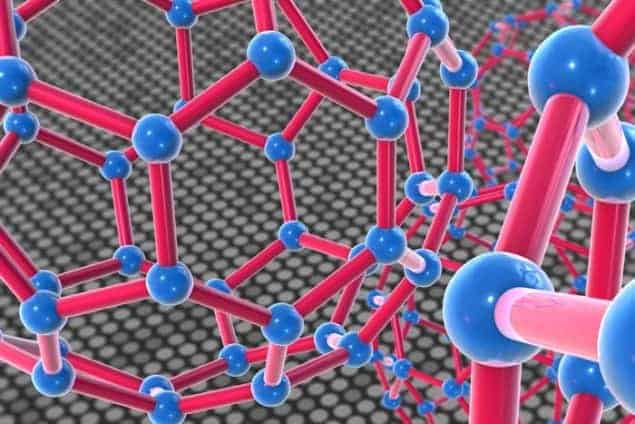
A new form of carbon that is hard enough to indent diamond has been created by a team of researchers from the US and China. The new material, known as ordered amorphous carbon clusters (OACC), is structurally unique in having both crystalline and disordered elements. Created by a team led by Lin Wang of the Carnegie Institution for Science in the US, the material was made by subjecting solvated carbon-60 molecules to phenomenal pressures more than 300,000 times that of the atmosphere.
Carbon comes in many guises, including graphite, diamond, nanotubes, graphene and charcoal. But until now, all have been classified as either crystalline – built from repeating atomic units – or amorphous, that is, lacking the long-range structural order seen in crystals. As a crystalline material composed of amorphous clusters, OACC is the first hybridized carbon structure ever seen that is part amorphous and part crystalline.
Collapsing carbon cages
To make the new form of carbon, the researchers started with molecules of carbon-60 – highly organized spherical cages that resemble footballs because they are built from pentagonal and hexagonal rings of carbon. Wang and colleagues then inserted molecules of an organic solvent, m-xylene, in-between the balls, before compressing the material to immense pressures of more than 32 GPa. On inspection, the spherical carbon cages were found to have broken and collapsed in on themselves to become amorphous carbon clusters that remained locked in their places in a lattice by the solvent molecules.
“The solvent molecules play a crucial role,” explains Wang. “For pure carbon-60, when the carbon cages collapse, the entire crystal turns amorphous. But in this material, because there are some solvent molecules there, even when the carbon cages collapse, they don’t move around.”
Making an impression
But what really astounded Wang and colleagues was when they squeezed the new form of carbon to pressures of up to 60 GPa between the tips of a pair of diamonds in a diamond-anvil cell. When they released the pressure and then inspected their kit, they found that the diamonds – the hardest material in nature – had actually been indented by their sample.
The hardness of diamonds can be attributed to the fact that each carbon atom is joined to its neighbours by a quartet of strong covalent bonds. Simon Parsons, a molecular crystallographer at the University of Edinburgh in the UK who was not involved with the study, is intrigued that a molecular structure can approach this sort of hardness. “I would expect diamond with its fully 3D extended structural framework to be harder than something with occluded solvent molecules,” he says. “But that is not the case here.”
Molecular simulations backed up what the researchers found in the lab, namely that when pressures of up to 30 GPa are applied and removed, the carbon cages bounce back to their original crystalline shape. But with pressures of more than 32 GPa, the material undergoes a permanent transformation, with the bonds in the carbon-60 cages breaking and reforming. When the pressure is removed, the new superhard structure can be recovered to ambient conditions still intact. When the researchers heated the OACC to drive off the solvent, its long-range order disappeared and it was reduced to its collapsed disordered building blocks, thus further confirming the crucial role of the solvent in providing OACC’s periodicity.
The hard line
One potential advantage of the new material is that it is made at room temperature. But whether it could be economically competitive with synthetic diamond, which is created at temperatures of about 1500°C, remains to be seen. Nevertheless, the researchers believe that OACC could have a range of potential mechanical, electronic and electrochemical uses.
“We know that when we dope carbon-60 with some alkali metal, it can transform into a superconductor,” says Wang. “We do not yet know, but we can expect that [the new material] should have some interesting electronic properties too.”
For now, Wang and his team are continuing to test OACC’s properties and probe the atomic structure of its collapsed carbon clusters, as well as investigating what materials can be fabricated with alternative solvent molecules at high pressure.
It is this aspect that Parsons is most excited about. “The thing that stands out for me about this work”, he says, “is that carbon-60 will crystallize with various different solvents, and those solvates will each have a different periodicity, which enables you to engineer different crystal structures by changing the solvent.”
The research appears in Science.



